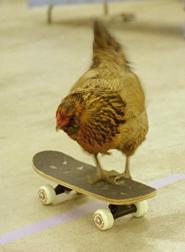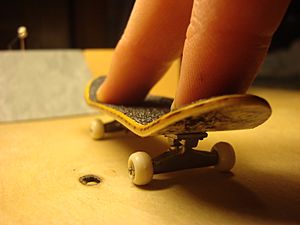Fingerboard (skateboard) facts for kids
A fingerboard is like a tiny skateboard that you "ride" with your fingers! It's a small copy of a real skateboard, usually about 100 millimeters (4 inches) long. It has all the parts of a real skateboard: a deck (the board part), trucks (the axles), and tiny wheels that really spin.
A famous skateboarder named Lance Mountain is often said to have invented the first fingerboard in the mid-1980s. He even showed how to make one in a magazine! For a long time, fingerboards were just a fun novelty. But in the late 1990s, a toy company called Spin Master saw how cool they were. They created the popular Tech Deck brand, which made fingerboards super popular.
Today, you can find fingerboards as simple toys or as fancy collector's items. Skateboarders also use them to practice and imagine new tricks. They can even make videos of their fingerboarding skills!
Similar to fingerboarding, hand boarding uses a slightly larger skateboard model. You control it with your whole hand instead of just your fingers. This lets you do even more complex tricks.
Contents
How People Use Fingerboards
People use fingerboards in many ways! Some use them just for fun as toys. Others, including professional skateboarders, use them to plan out new tricks. They can even help design courses for skateboarding competitions.
Just like people who build model trains, many fingerboard fans create tiny skateparks. They build or buy small models of things you'd see in a city. This includes handrails, benches, and stairs. They also make tiny versions of skatepark ramps like half-pipes, quarter pipes, and trick boxes.
These miniature parks are great for having fun and practicing. They also help fingerboarders imagine how to do tricks. They can plan out a whole series of tricks, called "lines." There are even special fingerboarding events where people show off their amazing models and accessories.
Parts of a Fingerboard
A fingerboard has several important parts. These include the deck, grip tape, trucks, bushings, and wheels. People often change or "mod" these parts to make their fingerboard lighter or look cooler.
The Deck
The deck is the main part of the fingerboard, like the board you stand on for a real skateboard. Decks come in many materials, from plastic to wood. Wooden decks are popular because they feel more real and help with tricks. Most decks have two "kicks," which are the flared ends used to lift the board. Older models might only have one kick. Modern decks usually have medium kicks and a slight curve called "concave."
Grip Tape
Grip tape is a special sticky tape on top of the deck. It helps your fingers grip the board so you can control it better. Some grip tape is like real skateboard grip tape. However, it can wear out faster from sweat and oils on your hands.
There are also softer grip tapes made from foam. These are gentler on your fingers, so you can play longer. Examples include Riptape and FBS Extra Smooth. These foam tapes have adhesive on the back to stick to the deck.
Trucks
Trucks are the metal parts attached to the bottom of the deck. They hold the wheels and bushings. Some trucks are made from one molded piece. Others are tiny versions of real skateboard trucks, like BRR Trucks or Y-Trucks. As fingerboarding has grown, you can find "pro" versions of trucks. These are shaped to be lighter and look better.
Bushings
Bushings are small, squishy pieces of material inside the trucks. On a real skateboard, they help you turn. On a fingerboard, they help keep the trucks stable. This makes it easier to do strong tricks and looks good too. "Pro" bushings are made from different soft materials, often rubber or rubberized plastic.
Wheels
The wheels affect how smoothly your fingerboard rolls. Professional fingerboard wheels are made from various materials. They often have tiny ball-bearings inside to make them roll super smoothly. Some popular brands include Flatface Wheels and Oak Wheels.
Types of Fingerboards

Tech Deck Fingerboards
Tech Deck makes fingerboards from hard plastic and wood. They use designs from famous skateboard companies like Blind and Element. Their decks have grip tape and cool graphics. Tech Deck trucks are usually made of metal and have separate axles for the wheels. The wheels and bushings are made of plastic.
Wooden Fingerboards
Many advanced fingerboarders prefer wooden decks. These are made from several thin layers of wood, like maple or walnut. They are often shaped by hand or with machines, which makes them more expensive. Wooden decks can cost from $5 to $60. You can even get custom designs! They come in different widths and concaves. Some companies let you choose the type of wood layers used.
Advanced fingerboarders also like wheels that are like real skateboard wheels. These are made from strong materials and have ball-bearings. Companies like Oak Wheels and Joycult Wheels make these. They use materials like teflon, urethane, and even clay. The wheels are carefully shaped, and then bearings are added for smooth rolling.
Other Fingerboard Accessories
Instead of basic parts, some fingerboarders use special tuning screws and custom kingpins. These help secure the wheels and trucks better. Brands like Blackriver Trucks make trucks designed for more precise movements. This lets fingerboarders pivot quickly and do tricks without their trucks falling apart. These special parts are often more expensive than regular Tech Deck items. You can also add "board rails" to the bottom of the deck, just like on a real skateboard.
Fingersnowboarding and Handboards
Fingersnowboarding
Similar to fingerboarding, fingersnowboarding is like snowboarding on a tiny snowboard with your fingers. In 1999, the first World Snowboard Fingerboard Championships was held. It even had a cash prize! Famous snowboarder Tom Sims competed and landed his fingersnowboard into a flaming shotglass. He donated his prize money to charity.
Handboards
Handboards are larger than fingerboards, about half or a third the size of a real skateboard. You control them with your whole hand, not just your fingers. Because they are bigger, handboards can have more detailed parts. For example, their trucks might be exactly like real skateboard trucks, not just simple molded pieces. This also means you can get handboards that look even more like full-sized skateboards.
Images for kids
See also
 In Spanish: Mini-tabla para niños
In Spanish: Mini-tabla para niños



